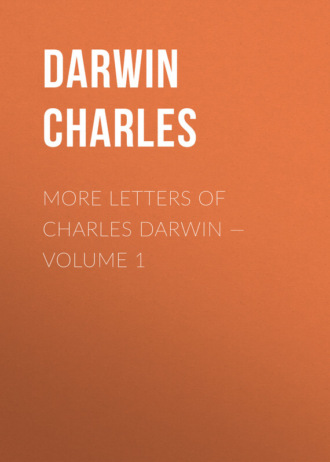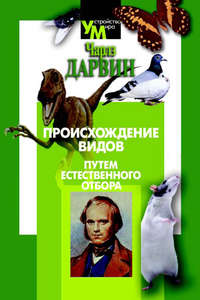 полная версия
полная версияMore Letters of Charles Darwin — Volume 1
May I keep the lists now returned? otherwise I will have them copied.
You said that you would give me a few cases of Australian forms and identical species going north by Malay Archipelago mountains to Philippines and Japan; but if these are given in your "Introduction" this will suffice for me. (340/3. See Hooker's "Introductory Essay," page l.)
Your lists seem to me wonderfully interesting.
According to my theoretical notions, I am not satisfied with what you say about local plants in S.W. corner of Australia (340/4. Sir Joseph replied in an undated letter: "Thanks for your hint. I shall be very cautious how I mention any connection between the varied flora and poor soil of S.W. Australia...It is not by the way only that the species are so numerous, but that these and the genera are so confoundedly well marked. You have, in short, an incredible number of VERY LOCAL, WELL MARKED genera and species crowded into that corner of Australia." See "Introductory Essay to the Flora of Tasmania," 1859, page li.), and the seeds not readily germinating: do be cautious on this; consider lapse of time. It does not suit my stomach at all. It is like Wollaston's confined land-snails in Porto Santo, and confined to same spots since a Tertiary period, being due to their slow crawling powers; and yet we know that other shell-snails have stocked a whole country within a very few years with the same breeding powers, and same crawling powers, when the conditions have been favourable to the life of the introduced species. Hypothetically I should rather look at the case as owing to — but as my notions are not very simple or clear, and only hypothetical, they are not worth inflicting on you.
I had vowed not to mention my everlasting Abstract (340/5. The "Origin of Species" was abbreviated from the MS. of an unpublished book.) to you again, for I am sure I have bothered you far more than enough about it; but as you allude to its previous publication I may say that I have chapters on Instinct and Hybridism to abstract, which may take a fortnight each; and my materials for Palaeontology, Geographical Distribution and Affinities being less worked up, I daresay each of these will take me three weeks, so that I shall not have done at soonest till April, and then my Abstract will in bulk make a small volume. I never give more than one or two instances, and I pass over briefly all difficulties, and yet I cannot make my Abstract shorter, to be satisfactory, than I am now doing, and yet it will expand to small volume.
LETTER 341. TO J.D. HOOKER. Down {November?} 27th {1858}.
What you say about the Cape flora's direct relation to Australia is a great trouble to me. Does not Abyssinia highland, (341/1. In a letter to Darwin, December 21st (?), 1858, Sir J.D. Hooker wrote: "Highlands of Abyssinia will not help you to connect the Cape and Australian temperate floras: they want all the types common to both, and, worse than that, India notably wants them. Proteaceae, Thymeleae, Haemodoraceae, Acacia, Rutaceae, of closely allied genera (and in some cases species), are jammed up in S.W. Australia, and C.B.S. {Cape of Good Hope}: add to this the Epacrideae (which are mere (paragraph symbol) of Ericaceae) and the absence or rarity of Rasaceae, etc., etc., and you have an amount {of} similarity in the floras and dissimilarity to that of Abyssinia and India in the same features that does demand an explanation in any theoretical history of Southern vegetation."), and the mountains on W. coast in some degree connect the extra-tropical floras of Cape and Australia? To my mind the enormous importance of the Glacial period rises daily stronger and stronger. I am very glad to hear about S.E. and S.W. Australia: I suspected after my letter was gone that the case must be as it is. You know of course that nearly the same rule holds with birds and mammals. Several years ago I reviewed in the "Annals of Natural History," (341/2. "Annals and Mag. of Nat. Hist." Volume XIX., 1847, pages 53-56, an unsigned review of "A Natural History of the Mammalia," by G.R. Waterhouse, Volume I. The passage referred to is at page 55: "The fact of South Australia possessing only few peculiar species, it having been apparently colonised from the eastern and western coasts, is very interesting; for we believe that Mr. Robert Brown has shown that nearly the same remark is applicable to the plants; and Mr. Gould finds that most of the birds from these opposite shores, though closely allied, are distinct. Considering these facts, together with the presence in South Australia of upraised modern Tertiary deposits and of extinct volcanoes, it seems probable that the eastern and western shores once formed two islands, separated from each other by a shallow sea, with their inhabitants generically, though not specifically, related, exactly as are those of New Guinea and Northern Australia, and that within a geologically recent period a series of upheavals converted the intermediate sea into those desert plains which are now known to stretch from the southern coast far northward, and which then became colonised from the regions to the east and west." On this point see Hooker's "Introductory Essay to the Flora of Tasmania," page ci, where Jukes' views are discussed. For an interesting account of the bearings of the submergence of parts of Australia, see Thiselton-Dyer, "R. Geogr. Soc. Jour." XXII., No. 6.) Waterhouse's "Mammalia," and speculated that these two corners, now separated by gulf and low land, must have existed as two large islands; but it is odd that productions have not become more mingled; but it accords with, I think, a very general rule in the spreading of organic beings. I agree with what you say about Lyell; he learns more by word of mouth than by reading.
Henslow has just gone, and has left me in a fit of enthusiastic admiration of his character. He is a really noble and good man.
LETTER 342. TO G. BENTHAM. Down, December 1st {1858?}.
I thank you for so kindly taking the trouble of writing to me, on naturalised plants. I did not know of, or had forgotten, the clover case. How I wish I knew what plants the clover took the place of; but that would require more accurate knowledge of any one piece of ground than I suppose any one has. In the case of trees being so long-lived, I should think it would be extremely difficult to distinguish between true and new spreading of a species, and a rotation of crop. With respect to your idea of plants travelling west, I was much struck by a remark of yours in the penultimate "Linnean Journal" on the spreading of plants from America near Behring Straits. Do you not consider so many more seeds and plants being taken from Europe to America, than in a reverse direction, would go some way to account for comparative fewness of naturalised American plants here? Though I think one might wildly speculate on European weeds having become well fitted for cultivated land, during thousands of years of culture, whereas cultivated land would be a new home for native American weeds, and they would not consequently be able to beat their European rivals when put in contest with them on cultivated land. Here is a bit of wild theory! (342/1. See Asa Gray, "Scientific Papers," 1889, Volume II., page 235, on "The Pertinacity and Predominance of Weeds," where the view here given is adopted. In a letter to Asa Gray (November 6th, 1862), published in the "Life and Letters," II., page 390, Darwin wrote: "Does it not hurt your Yankee pride that we thrash you so confoundedly? I am sure Mrs. Gray will stick up for your own weeds. Ask her whether they are not more honest downright good sort of weeds.")
But I did not sit down intending to scribble thus; but to beg a favour of you. I gave Hooker a list of species of Silene, on which Gartner has experimentised in crossing: now I want EXTREMELY to be permitted to say that such and such are believed by Mr. Bentham to be true species, and such and such to be only varieties. Unfortunately and stupidly, Gartner does not append author's name to the species.
Thank you heartily for what you say about my book; but you will be greatly disappointed; it will be grievously too hypothetical. It will very likely be of no other service than collocating some facts; though I myself think I see my way approximately on the origin of species. But, alas, how frequent, how almost universal it is in an author to persuade himself of the truth of his own dogmas. My only hope is that I certainly see very many difficulties of gigantic stature.
If you can remember any cases of one introduced species beating out or prevailing over another, I should be most thankful to hear it. I believe the common corn-poppy has been seen indigenous in Sicily. I should like to know whether you suppose that seedlings of this wild plant would stand a contest with our own poppy; I should almost expect that our poppies were in some degree acclimatised and accustomed to our cornfields. If this could be shown to be so in this and other cases, I think we could understand why many not-trained American plants would not succeed in our agrarian habitats.
LETTER 343. TO J.D. HOOKER.
(343/1. Mr. Darwin used the knowledge of the spread of introduced plants in North America and Australia to throw light on the cosmic migration of plants. Sir J.D. Hooker apparently objected that it was not fair to argue from agrarian to other plants; he also took a view differing slightly from that of Darwin as to climatal and other natural conditions favouring introduced plants in Australia.)
Down, January 28th, 1859.
Thanks about glaciers. It is a pleasure and profit to me to write to you, and as in your last you have touched on naturalised plants of Australia, I suppose you would not dislike to hear what I can say in answer. At least I know you would not wish me to defer to your authority, as long as not convinced.
I quite agree to what you say about our agrarian plants being accustomed to cultivated land, and so no fair test. Buckman has, I think, published this notion with respect to North America. With respect to roadside plants, I cannot feel so sure that these ought to be excluded, as animals make roads in many wild countries. (343/2. In the account of naturalised plants in Australia in Sir J.D. Hooker's "Introductory Essay to the Flora of Tasmania," 1859, page cvi, many of the plants are marked "Britain — waste places," "Europe — cornfields," etc. In the same list the species which have also invaded North America — a large number — are given. On the margin of Darwin's copy is scribbled in pencil: "Very good, showing how many of the same species are naturalised in Australia and United States, with very different climates; opposed to your conclusion." Sir Joseph supposed that one chief cause of the intrusion of English plants in Australia, and not vice versa, was the great importation of European seed to Australia and the scanty return of Australian seed.)
I have now looked and found passage in F. Muller's (343/3. Ferdinand Muller.) letter to me, in which he says: "In the WILDERNESSES of Australia some European perennials are "advancing in sure progress," "not to be arrested," etc. He gives as instances (so I suppose there are other cases) eleven species, viz., 3. Rumex, Poterium sanguisorba, Potentilla anserina, Medicago sativa, Taraxacum officinale, Marrubium vulgare, Plantago lanceolata, P. major, Lolium perenne. All these are seeding freely. Now I remember, years and years ago, your discussing with me how curiously easily plants get naturalised on uninhabited islands, if ships even touch there. I remember we discussed packages being opened with old hay or straw, etc. Now think of hides and wool (and wool exported largely over Europe), and plants introduced, and samples of corn; and I must think that if Australia had been the old country, and Europe had been the Botany Bay, very few, very much fewer, Australian plants would have run wild in Europe than have now in Australia.
The case seems to me much stronger between La Plata and Spain.
Nevertheless, I will put in my one sentence on this head, illustrating the greater migration during Glacial period from north to south than reversely, very humbly and cautiously. (343/4. "Origin of Species," Edition I., page 379. Darwin refers to the facts given by Hooker and De Candolle showing a stronger migratory flow from north to south than in the opposite direction. Darwin accounts for this by the northern plants having been long subject to severe competition in their northern homes, and having acquired a greater "dominating power" than the southern forms. "Just in the same manner as we see at the present day that very many European productions cover the ground in La Plata, and in a lesser degree in Australia, and have to a certain extent beaten the natives; whereas extremely few southern forms have become naturalised in any part of Europe, though hides, wool, and other objects likely to carry seeds have been largely imported during the last two or three centuries from La Plata, and during the last thirty or forty years from Australia.')
I am very glad to hear you are making good progress with your Australian Introduction. I am, thank God, more than half through my chapter on geographical distribution, and have done the abstract of the Glacial part...
LETTER 344. TO J.D. HOOKER. Down, March 30th, 1859.
Many thanks for your agreeable note. Please keep the geographical MS. till you hear from me, for I may have to beg you to send it to Murray; as through Lyell's intervention I hope he will publish, but he requires first to see MS. (344/1. "The Origin of Species"; see a letter to Lyell in "Life and Letters," II., page 151.)
I demur to what you say that we change climate of the world to account for "migration of bugs, flies, etc." WE do nothing of the sort; for WE rest on scored rocks, old moraines, arctic shells, and mammifers. I have no theory whatever about cause of cold, no more than I have for cause of elevation and subsidence; and I can see no reason why I should not use cold, or elevation, or subsidence to explain any other phenomena, such as distribution. I think if I had space and time I could make a pretty good case against any great continental changes since the Glacial epoch, and this has mainly led me to give up the Lyellian doctrine as insufficient to explain all mutations of climate.
I was amused at the British Museum evidence. (344/2. This refers to the letter to Murchison (Letter 65), published with the evidence of the 1858 enquiry by the Trustees of the British Museum.) I am made to give my opinion so authoritatively on botanical matters!..
As for our belief in the origin of species making any difference in descriptive work, I am sure it is incorrect, for I did all my barnacle work under this point of view. Only I often groaned that I was not allowed simply to decide whether a difference was sufficient to deserve a name.
I am glad to hear about Huxley — a wonderful man.
LETTER 345. TO J.D. HOOKER. Wells Terrace, Ilkley, Otley, Yorkshire, Thursday {before December 9th, 1859}.
I have read your discussion (345/1. See "Introductory Essay," page c. Darwin did not receive this work until December 23rd, so that the reference is to proof-sheets.), as usual, with great interest. The points are awfully intricate, almost at present beyond the confines of knowledge. The view which I should have looked at as perhaps most probable (though it hardly differs from yours) is that the whole world during the Secondary ages was inhabited by marsupials, araucarias (Mem. — Fossil wood so common of this nature in South America (345/2. See Letter 6, Note.)), Banksia, etc.; and that these were supplanted and exterminated in the greater area of the north, but were left alive in the south. Whence these very ancient forms originally proceeded seems a hopeless enquiry.
Your remarks on the passage of the northern forms southward, and of the southern forms of no kinds passing northward, seem to me grand. Admirable, also, are your remarks on the struggle of vegetation: I find that I have rather misunderstood you, for I feared I differed from you, which I see is hardly the case at all. I cannot help suspecting that you put rather too much weight to climate in the case of Australia. La Plata seems to present such analogous facts, though I suppose the naturalisation of European plants has there taken place on a still larger scale than in Australia...
You will get four copies of my book — one for self, and three for the foreign botanists — in about ten days, or sooner; i.e., as soon as the sheets can be bound in cloth. I hope this will not be too late for your parcels.
When you read my volume, use your pencil and score, so that some time I may have a talk with you on any criticisms.
LETTER 346. TO HUGH FALCONER. Down, December 17th, {1859}.
Whilst I think of it, let me tell you that years ago I remember seeing in the Museum of the Geological Society a tooth of hippopotamus from Madagascar: this, on geographical and all other grounds, ought to be looked to. Pray make a note of this fact. (346/1. At a meeting of the Geological Society, May 1st, 1833, a letter was read from Mr. Telfair to Sir Alex. Johnstone, accompanying a specimen of recent conglomerate rock, from the island of Madagascar, containing fragments of a tusk, and part of a molar tooth of a hippopotamus ("Proc. Geol. Soc." 1833, page 479). There is a reference to these remains of hippopotamus in a paper by Mr. R.B. Newton in the "Geol. Mag." Volume X., 1893; and in Dr. Forsyth Major's memoir on Megaladapis Madagascariensis ("Phil. Trans. R. Soc." Volume 185, page 30, 1894).
Since this letter was written, several bones belonging to two or possibly three species of hippopotamus have been found in Madagascar. See Forsyth Major, "On the General Results of a Zoological Expedition to Madagascar in 1894-96" ("Proc. Zool. Soc." 1896, page 971.))
We have returned a week ago from Ilkley, and it has done me some decided good. In London I saw Lyell (the poor man who has "rushed into the bosom of two heresies" — by the way, I saw his celts, and how intensely interesting), and he told me that you were very antagonistic to my views on species. I well knew this would be the case. I must freely confess, the difficulties and objections are terrific; but I cannot believe that a false theory would explain, as it seems to me it does explain, so many classes of facts. Do you ever see Wollaston? He and you would agree nicely about my book (346/2. "Origin of Species," 1859.) — ill luck to both of you. If you have anything at all pleasant for me to hear, do write; and if all that you can say is very unpleasant, it will do you good to expectorate. And it is well known that you are very fond of writing letters. Farewell, my good old friend and enemy.
Do make a note about the hippopotamus. If you are such a gentleman as to write, pray tell me how Torquay agrees with your health.
(PLATE: DR. ASA GRAY, 1867.)
LETTER 347. TO ASA GRAY. Down, December 24th {1859}.
I have been for ten weeks at Water-cure, and on my return a fortnight ago through London I found a copy of your Memoir, and heartily do I thank you for it. (347/1. "Diagnostic Characters of New Species of Phaenogamous Plants collected in Japan by Charles Wright...with Observations upon the Relations of the Japanese Flora to that of North America and of other parts of the Northern Temperate Zone" ("Mem. American Acad. Arts and Sci." Volume VI., page 377, 1857).) I have not read it, and shall not be able very soon, for I am much overworked, and my stomach has got nearly as bad as ever.
With respect to the discussion on climate, I beg you to believe that I never put myself for a moment in competition with Dana; but when one has thought on a subject, one cannot avoid forming some opinion. What I wrote to Hooker I forget, after reading only a few sheets of your Memoir, which I saw would be full of interest to me. Hooker asked me to write to you, but, as I told him, I would not presume to express an opinion to you without careful deliberation. What he wrote I know not: I had previously several years ago seen (by whom I forget) some speculation on warmer period in the U. States subsequent to Glacial period; and I had consulted Lyell, who seemed much to doubt, and Lyell's judgment is really admirably cautious. The arguments advanced in your paper and in your letter seem to me hardly sufficient; not that I should be at all sorry to admit this subsequent and intercalated warmer period — the more changes the merrier, I think. On the other hand, I do not believe that introduction of the Old World forms into New World subsequent to the Glacial period will do for the modified or representative forms in the two Worlds. There has been too much change in comparison with the little change of isolated alpine forms; but you will see this in my book. (347/2. "Origin of Species" (1859), Chapter XI., pages 365 et seq.) I may just make a few remarks why at first sight I do not attach much weight to the argument in your letter about the warmer climate. Firstly, about the level of the land having been lower subsequently to Glacial period, as evidenced by the whole, etc., I doubt whether meteorological knowledge is sufficient for this deduction: turning to the S. hemisphere, it might be argued that a greater extent of water made the temperature lower; and when much of the northern land was lower, it would have been covered by the sea and intermigration between Old and New Worlds would have been checked. Secondly, I doubt whether any inference on nature of climate can be deduced from extinct species of mammals. If the musk-ox and deer of great size of your Barren-Grounds had been known only by fossil bones, who would have ventured to surmise the excessively cold climate they lived under? With respect to food of large animals, if you care about the subject will you turn to my discussion on this subject partly in respect to the Elephas primigenius in my "Journal of Researches" (Murray's Home and Colonial Library), Chapter V., page 85. (347/3. "The firm conviction of the necessity of a vegetation possessing a character of tropical luxuriance to support such large animals, and the impossibility of reconciling this with the proximity of perpetual congelation, was one chief cause of the several theories of sudden revolutions of climate...I am far from supposing that the climate has not changed since the period when these animals lived, which now lie buried in the ice. At present I only wish to show that as far as quantity of food alone is concerned, the ancient rhinoceroses might have roamed over the steppes of Central Siberia even in their present condition, as well as the living rhinoceroses and elephants over the karoos of Southern Africa" ("Journal of Researches," page 89, 1888).) In this country we infer from remains of Elephas primigenius that the climate at the period of its embedment was very severe, as seems countenanced by its woolly covering, by the nature of the deposits with angular fragments, the nature of the co-embedded shells, and co-existence of the musk-ox. I had formerly gathered from Lyell that the relative position of the Megatherium and Mylodon with respect to the Glacial deposits, had not been well made out; but perhaps it has been so recently. Such are my reasons for not as yet admitting the warmer period subsequent to Glacial epoch; but I daresay I may be quite wrong, and shall not be at all sorry to be proved so.
I shall assuredly read your essay with care, for I have seen as yet only a fragment, and very likely some parts, which I could not formerly clearly understand, will be clear enough.
LETTER 348. TO J.D. HOOKER. Down, {December} 26th, {1859}.
I have just read with intense interest as far as page xxvi (348/1. For Darwin's impression of the "Introductory Essay to the Tasmanian Flora" as a whole, see "Life and Letters," II., page 257.), i.e. to where you treat of the Australian Flora itself; and the latter part I remember thinking most of in the proof-sheets. Either you have altered a good deal, or I did not see all or was purblind, for I have been much more interested with all the first part than I was before, — not that I did not like it at first. All seems to me very clearly written, and I have been baulked at only one sentence. I think, on the whole, I like the geological, or rather palaeontological, discussion best: it seems to me excellent, and admirably cautious. I agree with all that you say as far as my want of special knowledge allows me to judge.









